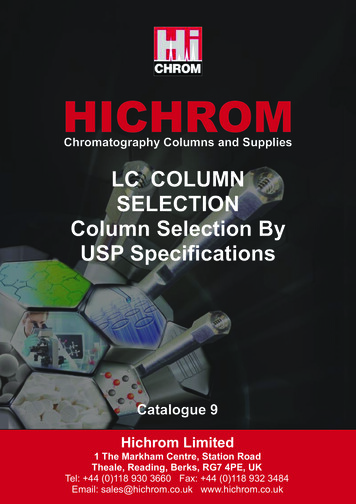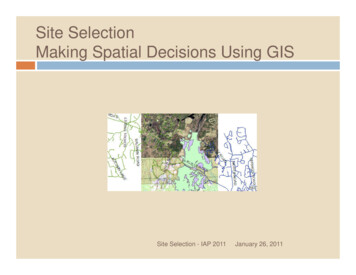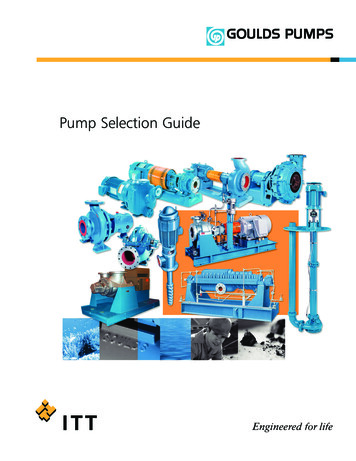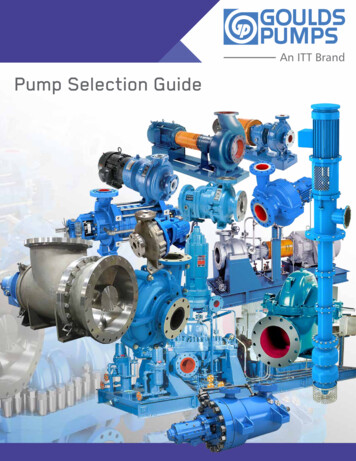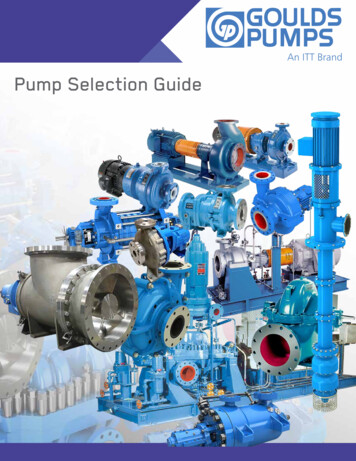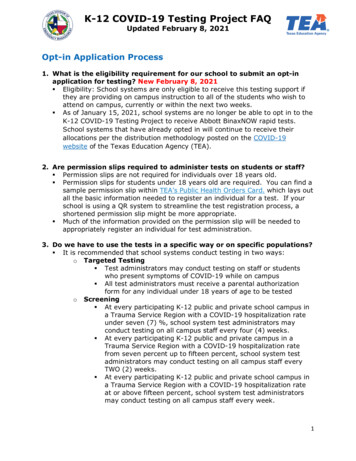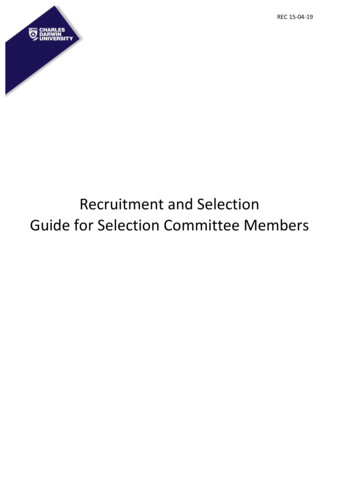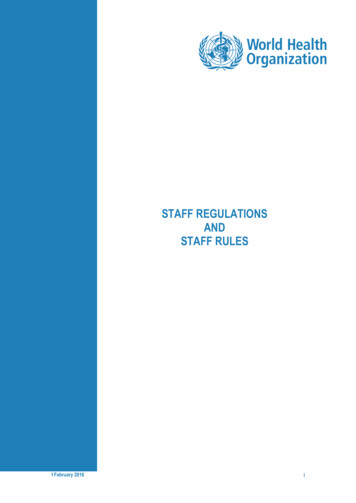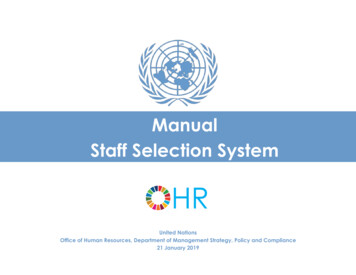
Transcription
ManualStaff Selection SystemUnited NationsOffice of Human Resources, Department of Management Strategy, Policy and Compliance21 January 2019
Table of ContentsChapter 1: The staff selection system . 1Staff selection manual . 1Human Resources Management Scorecard . 1Performance target: staffing timelines . 1Performance target: gender parity & geographical diversity . 1Inspira business roles . 2System updates and enhancements . 4 Inspira tips . 5Chapter 2: Creating job openings . 7Creation of a job request by hiring managers. 7Review of the job request by staffing table managers . 13Approve or deny job requests: . 13 Inspira tips . 14Chapter 3: Approving job openings . 19Approve, push back or deny job requests . 19Review of the job details . 19Review of evaluation criteria and job posting . 19Review of evaluation criteria by the central review bodies . 19Translation in English or French . 19Publishing job openings . 19 Inspira tips . 20Chapter 4: Screening applications. 23Automated screening rules . 23Screening based on mandatory questions related to integrity and performancestandards . 24HR Assessment . 24Changing dispositions after HR Assessment . 26Completing HR assessment . 26 Inspira tips . 27Chapter 5: Recommending roster candidates . 29Identifying roster candidates . 29Consideration of roster candidates . 29Preparing for the recommendation of roster candidates . 29 Inspira tips . 30Chapter 6: Preliminary evaluation . 31Recording evaluation results. 31Disposition definitions: not suitable, long list, remain in long list, short list . 31Evaluating academic qualifications . 32Evaluating work experience . 32Evaluating language proficiency . 32Evaluation tools . 32 Inspira tips . 34Chapter 7: Assessments . 39Assessment panel . 39Inviting applicants for assessment. 39Assessments other than competency-based interviews . 39Competency-based interviews . 39Finalizing and recording assessment results. 40 Inspira tips . 42Chapter 8: Preparing for compliance review . 45Preparing the transmittal memo . 45Comparative analysis report review and final checks . 45Internal approval of recommendations . 45Submission of the transmittal memo . 45 Inspira tips . 46Chapter 9: Compliance review . 47Checklist for recruiters . 47Status Matrix update by recruiters . 47Submission to the central review bodies. 49Review by the central review bodies . 49 Inspira tips . 50Chapter 10: Selection . 53Considering integrity and performance . 53Other selection considerations: Status Matrix . 53Notification to candidates after selection . 54Selection or offer decline, or departure of selected candidate . 55 Inspira tips . 56Chapter 11: Cancelling job openings . 58Before compliance review by the review bodies . 58During or after compliance review by the review bodies . 58Other reasons for cancellation . 58Reflecting cancellation decisions in Inspira . 58 Inspira tips . 59Chapter 12: Rosters . 60Roster candidates and roster . 60Inclusion in the roster . 60Roster search . 60 Inspira tips . 61Annexes . 62Annex I Education and work experience requirements . 62Annex II Eligibility determination based on job opening level, and staff level and jobcategory . 64
Chapter 1: The staff selection systemStaff selection manual1. This manual provides guidance to staff members responsible for theadministration of the staff selection system according to administrativeinstruction ST/AI/2010/3. Staff members should pay special attention to thechapters specified below according to their role:Hiring managers: 1, 2, 5, 6, 7, 8, 9, 10Staffing table managers: 1, 2, 5, 8, 10, 12Senior recruiters and recruiters: all chaptersSenior Review Group (SRG) and central review body (CRB) members:3, 9 Heads of departments, offices, missions and other major organizationalunits who have direct delegation from the Secretary-General for staffselection decisions up to D-1 (hereinafter, heads of departments,offices and missions): 1, 10, 11 Occupational group managers may perform the hiring manager, staffingtable manager and recruiter roles, and should refer to all the relevantchapters.2. The manual explains the standard procedures and best administrativepractices to be followed for the implementation of ST/AI/2010/3, includingadvice on how to use the UN talent management platform, Inspira. Thismanual shall not be construed to grant any entitlement to applicants. ForD-2 level job openings, additional or different requirements to this manualmay apply. Those requirements will be provided to relevant stakeholdersof the staff selection process by the Secretariat of the Senior Review Group.3. Heads of departments, offices and missions with full delegation forhuman resources management and their delegatees may approveexceptions from ST/AI/2010/3 as long as they are consistent with GeneralAssembly resolutions and the Staff Regulations and Rules. All suchexceptions shall be fully documented, including the reasons thereof, andshall be reported to the Under-Secretary-General for ManagementStrategy, Policy and Compliance.4. Exceptions from the current manual may also be approved by headsof offices, departments and missions with full delegation for humanresources management in a manner consistent with General Assemblyresolutions, the Staff Regulations and Rules and administrative issuances.Although there is no requirement to report exceptions from the manual tothe Under-Secretary-General for Management Strategy, Policy and1 PageCompliance, the exceptions should be fully documented and recordedinternally.Human Resources Management Scorecard5. The Secretary-General annually enters the Senior Managers’ Compactwith the heads of department, office or mission to hold them accountablefor meeting several managerial priorities. Human resources managementtargets of the compact are monitored through the Human ughhttps://hrinsight.un.org.6. Heads of department, office and mission, as well as the executive andadministrative officers supporting them, should regularly monitor theperformance of their respective work unit on staffing timelines, vacancyrate, geographical representation and representation of women toachieve the Senior Managers’ Compact goals.Performance target: staffing timelines7. Heads of department, office and mission are accountable forcompleting relevant staff selection process within the following timelinesfrom the first day of advertisement: 86 calendar days for recruit from roster job openings for positions in fieldmissions; 126 calendar days for other job openings for positions in field missions;and 120 calendar days for all job openings for positions which are not in fieldmissions.Performance target: gender parity & geographical diversity8. Heads of departments, offices and missions have pledged theircommitment to achieve 50/50 gender parity at all levels in the Professionaland higher categories and to have a geographically diverse workforce.Conducting staff selection processes that take into consideration genderand geographic factors from beginning to end is essential to meet theseobjectives. Inspira is equipped with the tools for considering applicants'gender and nationality.Gender parity:9. The latest gender parity data for each department, office or mission isavailable at https://www.un.org/gender. Efforts shall be made to ensurethat the pool of applicants for each job opening is gender balanced.Geographical diversity:
10. The UN Secretariat monitors the nationality of incumbents ofapproximately 3,600 established positions funded from the regular budget(i.e. geographical posts) in addition to staff members recruited through theyoung professionals programme. Based on this population, thegeographical representation of Member States is determined as eitherunrepresented, underrepresented, within range (below midpoint), withinrange (above midpoint) or overrepresented. The heads of departmentsand offices have pledged to select applicants from unrepresented orunderrepresented Member States for at least 50 per cent of geographicalpost vacancies in the Senior Managers’ Compact with the SecretaryGeneral. 11. In addition, the heads of departments, offices and missions havepledged to make progress towards achieving greater regionaldiversification among Africa, Asia Pacific, Eastern Europe, Latin Americaand the Caribbean and Western Europe and Others. For the classificationof Member States per regional group, .shtmlWbWithin range, below midpointWaWithin range, above midpointOvOverrepresentedRegion column: hiring managers can see the regional group to whichthe applicant’s country of nationality belongs in the job openinglanding page in the Region column.IndicatorDescriptionAFGAfrican GroupAPGAsia-Pacific GroupEEGEastern European GroupGRULACLatin American and Caribbean GroupWEOGWestern European and Others Group12. For geographical posts, efforts shall be made to ensure that dueconsideration is given to applicants from Member States which areunrepresented or underrepresented and from Member States from regionalgroups which are not well represented within the department or office.Tools for considering gender and geographical representation:13. The following tools are available in Inspira for each job opening ( Inspira tip 1.1) for the consideration of gender and geographicalrepresentation status: Gender data: above the applicant list on the job opening landingpage, hiring managers will see the number of applicants per gender ineach disposition (e.g. Screen, Long List, Short List, Recommended).Gender column: hiring managers can see the gender of eachapplicant in the job opening landing page in the Gender column.Nationality column: hiring managers can see the nationality of eachapplicant in the job opening landing page in the Nationality column.Geographical representation column: hiring managers can see thegeographical representation status of applicant’s country of nationalityin the job opening landing page in the Geo Rep column.IndicatorDescription2 PageUnUnrepresentedUdUnderrepresented Gender, geographical and region summary reports: these reportsprovide an overview of the applicants’ gender, geographicalrepresentation and region information and a historical overview of howmany applicants per gender and nationality were placed in differentdispositions throughout the staff selection process ( Inspira tip 1.2).Inspira business roles14. Each department, office or mission has its own business unit establishedin Inspira. Appropriate business roles for the business unit should be grantedto staff members to administer the staff selection process in Inspira. Therequesting and approving of business role accesses are critical functionsthat ensure security, internal control and confidentiality of the informationrelated to the staff selection process for the business unit.
15. The business role approvals are submitted through Inspira or UniteService Desk using the form provided by the Office of Human Resources inthe Department of Management Strategy, Policy and Compliance ( Inspira tip 1.3).Senior Recruiter/Senior HumanResources CaseOfficer (SHRCO)16. The table below provides the list of business roles related to recruitment:Business role& type of roleType of role and descriptionRecruitment rolesHead ofDepartment (HoD)Hiring Manager/Program CaseOfficerStaffing TableManager (STM)3 PageThis role is given to heads of departments, officesand missions or other major organizational units,normally at USG, ASG or D-2 level, who have beendelegated the authority to make selectiondecisions up to D-1 level directly from theSecretary-General. Such officials may subdelegatethe staff selection authority and approve thegranting of this role to other officials. The HoD rolegives access to all historic and current jobopenings for the department, office or mission.This role is given to staff members who are taskedto manage the process of filling specific positionsin a department, office or mission. This role isneeded to request the issuance of job openingsand record the evaluation and assessmentprocess in Inspira. Staff members at the P-3 leveland above are automatically granted this role.Hiring managers only have access to the specificjob openings for which they are included in thehiring team.This role is given to staff members who have theresponsibility for managing the staffing table of thedepartment, office or mission or other majororganizational units, and have the requisiteinformation to review and approve all aspects ofthe job requests submitted by the hiring managers,particularly funding availability and accuracy ofpost nature (e.g. geographical, language). STMrole gives access to all historic and current jobopenings for the department, office or mission.Recruiter/HumanResources CaseOfficer (HRCO)Question LibraryManagerOccupationalGroup Manager(OGM) [forgeneric/continuousjob openings only]HR/ExecutiveOffice[for temporary jobopenings only]AuthorizedSelection Delegate[for temporary jobopenings only]This role is given to staff members responsible forreviewing job requests and deciding whether theycould be further routed to recruiters for a detailedreview. Senior recruiters should normally be staffmembers at P-3 level or above with humanresources expertise. Senior recruiters only haveaccess to the specific job openings for which theyare included in the hiring team.This role is given to staff members responsible forconducting a detailed review of job requests foradvertisements (in both English and French forpositions subject to international recruitment);issuing job openings; conducting HR assessment(see Chapter 4); conducting compliance review;submitting recruitment cases to the central reviewbodies; and other ancillary tasks. Recruiters onlyhave access to the specific job openings they areincluded in the hiring team.This role is given to staff members who have theauthority to add screening questions to thequestion library. Such questions may then beadded to job openings and temporary jobopenings. Staff members with the senior recruiterrole are normally granted this access.This role is given to staff members in the humanresources offices with the authority for issuinggeneric generic/continuous job openingsadvertised for the purposes of creating rosters forthe field.This role is given to staff members responsible forreviewing, approving and issuing temporary jobopenings. This combines the staffing tablemanager, senior recruiter and recruiter roles in theregular recruitment process.This role is given to heads of departments, officesand missions or other major organizational units,normally at USG, ASG or D-2 level, who have beendelegated the authority to make selectiondecisions up to D-1 level directly from theSecretary-General. Such officials may subdelegatethe staff selection authority and approve thegranting of this role to other officials.
Central review body rolesCentral ReviewBody – SecretaryThis role is given to staff members working in theCentral Review Body Secretariat.Central ReviewBody – ChairThis role is given to the Chairpersons of the SeniorReview Group and the central review bodies.Central ReviewBody – MemberThis role is given to the members of the SeniorReview Group and the central review bodies.Human ResourcesEx-OfficioThis role is given to staff members with humanresources expertise who are not part of the CRBSecretariat and who serve as ex officio non-votingmember of the central review bodies.Department FocalPoint for WomenThis role is given to the focal point for womendesignated by the department, office or mission toparticipate in advisory capacity in the meetings ofthe central review bodies.17. Heads of departments, offices and missions may grant or revoke therecruitment business accesses for staff members in their respectiveorganizational units. The senior executive, administrative or humanresources officers who have the functional delegation for the managementof the respective organizational units, have the authority for approvingInspira business roles except for the selection-associated roles, unlessotherwise excluded by the relevant heads of departments, offices andmissions. The signatories for Inspira business role requests should be mindfulthat they remain accountable and responsible for the exercise ofdelegated authority that they subdelegate by approving the granting ofInspira business roles particularly when higher level roles normally reservedfor the senior managers are granted to other staff members.18. All business roles should be removed from staff transferring out of adepartment, office or mission. Inspira will automatically remove the rolesfrom staff who are separated.System updates and enhancements19. All staff members are given an employee account upon appointment.Inspira employee accounts give access to the What’s New on the Inspiralanding page. This page provides up-to-date information on systemmaintenance and downtime schedules. Staff members with business roleshave access to the details of system enhancements, unless their role islimited to hiring manager.4 Page
Inspira tips(3) Click the posting title of the job opening of choice. 1.1: Find an existing job opening and go to the landing page(1) In Main Menu, select Recruiting Search Job Opening.(4) The job opening landing page appears.(2) Enter the search criteria and click ‘Search.’ 1.2: Generate gender, geographical and region summary reports(1) To generate the reports, from the job opening landing page, clickReports from the landing page, and select the relevant reportfrom the drop down.5 Page
1.2: Submit requests for Inspira business roles(1) In the main page of Inspira, click on the Inspira Role RequestInstructions and Forms.(2) Fill out the form and obtain the signature of the official who has therole approving authority according to the instruction.(3) Scan the document in .pdf version.(4) Submit the request at:(a) Inspira (https://inspira.un.org); or(b) Unite Self Service (https://ineedservice.un.org).6 Page
Chapter 2: Creating job openingsdescription) or a previously published job opening. These options aredescribed below:1. When a position is established, becomes vacant or is expected tobecome vacant, the hiring manager should initiate the staff selectionprocess in Inspira by submitting a job request to the staffing table manager.The staffing timeline starts once the job request is submitted to the staffingtable manager. Before initiating the staff selection process, the staffingtable managers should ensure that positions are classified according tostaff rule 2.1.(a)Generic job profile (GJP): If a GJP relevant to the position is available,hiring managers may utilize it as the basis for the creation of the jobopening following a classifiable advice indicating that the position isassociable to the GJP.(b)Standard job description (SJD): Once the evaluation criteria of a SJDbased job opening are reviewed and approved by a central reviewbody, subsequent job openings utilizing the same SJD may bereviewed and approved by recruiters if no major deviation exists (i.e.requirements remain unchanged while desirables may varydepending on the focus of the position in the specific location).(c)Individually classified job description: The evaluation criteria of jobopenings based on individually classified job description will bereviewed and approved by the central review bodies.(d)Previously published job opening: Job openings based on a previouslypublished job opening within one year may be reviewed andapproved by senior recruiters.Creation of a job request by hiring managers2. Hiring managers responsible for the staff selection process to fill vacantpositions available for one year or longer initiate the process by creating ajob request ( Inspira tip 2.1).3. When creating a job request, hiring managers should use one of thefollowing job opening types: Standard Requisition: vacancy announcement for all positions whichare not in the peacekeeping and special political missions and not atthe D-2 level Recruit from Roster: vacancy announcement used in peacekeepingand special political mission positions D2 level JO: vacancy announcement for D-2 level positions Continuous job opening: vacancy announcement for generic jobopenings, which is used to create rosters for the field.4. There is also the Temporary Job Opening which is used to fill short-termneeds of less than one year, which is not within the scope of this manual.5. A job opening must be based on an approved classification document(generic job profile, standard job description or an individually classified job7 Page6. Hiring managers should choose a job code, which will be reviewed bythe staffing table managers and recruiters. The job code is the functionaltitle of the position. It should be aligned with the approved classificationdocument for the position to be advertised. The choice of job code isimportant because it determines the relevant roster for the job opening. Formore information on the roster, read Chapter 12.7. After the Primary Job Opening Information, hiring managers are askedto fill out three additional pages with the assistance of the staffing tablemanagers: (1) Job Details; (2) Evaluation Criteria; and (3) Job Postings.Hiring managers should focus on filling out the mandatory fields markedwith an asterisk (*) on the screen. The staffing table managers areresponsible for ensuring all fields are correctly filled out.Job Details:8. The following table provides guidance on how to complete each fieldof the Job Details page ( Inspira tip 2.2).Openings to Fill(mandatory)This represents whether there are limited orunlimited openings for this position. Limited shouldbe used for standard requisitions, recruit fromroster or D-2 level JOs and Unlimited should beused for continuous/generic job openings.
Target OpeningsAvailableOpeningsBusiness UnitBy default, the value of this field is 1. It indicatesthe number of openings expected to be filled bythis job opening. For example, if the same jobopening will be used to fill two distinct positions,the value should be 2.By default, the value of this field is 1. It indicatesthe number of available vacancies and themaximum number of candidates that can beselected at the selection stage by this jobopening. It must be the same number as theTarget Openings at this stage.This is auto-populated from the Primary JobOpening Information. If it is not populated or isincorrect, it should be changed to the correctbusiness unit.Company(mandatory)This should always be UNS (United om the dropdown menu, the correctdepartment or office should be selected. It shouldnormally align with the department or officeselected for Business Unit.OrganizationalUnitThis is auto-populated from the Primary JobOpening Information if the Umoja position numberwas entered in that page. Otherwise, theorganizational unit may be entered in this field.Duty Station(mandatory)This indicates the du
86 calendar days for recruit from roster job openings for positions in field missions; 126 calendar days for other job openings for positions in field missions; and 120 calendar days for all job openings for positions which are not in field missions. Performance target:gender parity & geographicaldiversity 8.
